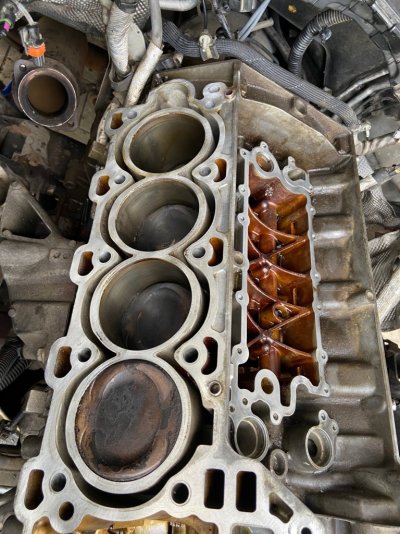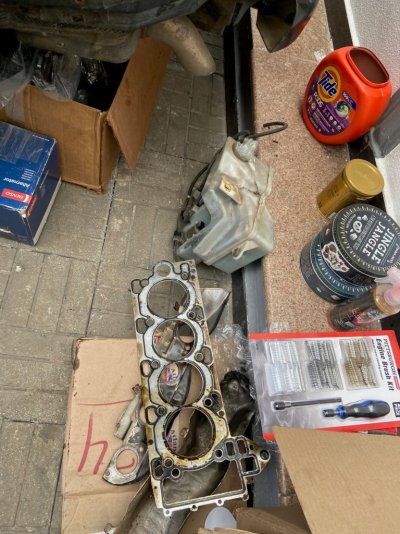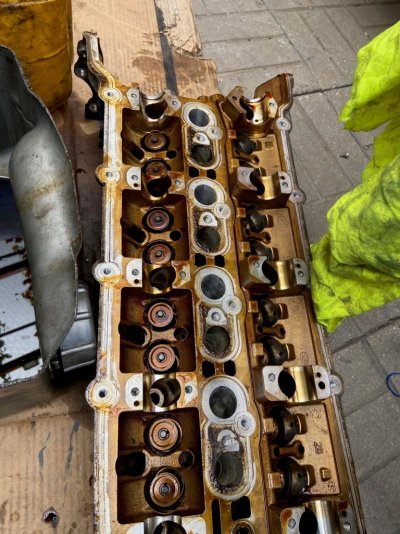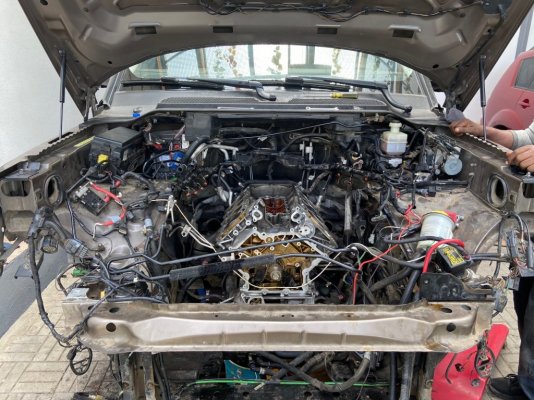Yup! In that first picture I’m oriented to what I’m seeing on the block — I see you have the oil cooler and lower half of the front coolant crossover pipe off.
Right - things are off.
Below are two photos of the engine bay that particular day.
We pulled everything out (and eventually even the engine itself in order to clean the oil pan and change the AUX chain and whatnot) so we went really deep in this thing.
So to do all of that, the job takes days and days. And if you are doing this alone, then days and days and days and days.
And you need the right (special and hand) tools, and the right parts, and....
We have been chatting about all this and I would say that the general consensus, and certainly my opinion, is taking out more is better.
But, this is tied to my own philosophy that servicing the engine to this particular level, you might as well do everything. But that is not necessarily what you want or need. The advantage to my approach, however, is that you can really take a look at all these bits and pieces and see what else is wrong and comprehensively service the whole system. I think that is invaluable...but time consuming. And any work on a Land Rover simply will not be cheap.
As you can see in these photographs, there is a ton of dirt and grime and some (not too bad but it is there) corrosion. All of that needed attention...which took more time. In fact, these photos are from almost two months ago and we are still doing some finishing touches on the engine bay (mostly complete at this point but not 100% finished with the engine).
Additionally, I replaced most things in there I could: all new pumps / pulleys, all new hoses (almost), complete drains and flushes of all fluids. But when firing her up now, my impression is that she sounds better than when I first got her (I might be completely not remembering but it sure seems that way).
Again, you don't have to do all of that but if you want to get at the heads you will need to pull a lot of stuff out (not necessarily the radiator and A/C but it will definitely make life a lot easier) in order to really get the access you need.
So the answer to your simple question is something like "it depends". It will depend upon how deep you want and need to go, it will depend on how fast you work, and it will depend upon what problems you encounter along the way. Right now, aspects of this you cannot yet know.
I don't want to discourage you at all. On the contrary, this job sounds totally doable; but it will take time and I want you to understand that up-front. I assume you have the workshop manual and in there you can see the time given to do certain jobs. It will probably say something absurd like "Head Removal: 8.75 hours". That is completely useless for our purposes since the engineers calculated exactly how long a master mechanic with all the right tools in a fully-kitted workshop would require working at maximum speed on a singular task on a completely new engine. Rather than worry about how many hours required for a particular job, I prefer to see it as "the journey and not the destination." Which is incredibly frustrating. But you should know that you can and will get to the bottom of this problem eventually, but this will be more about what you learn along the way.
All of which drives my wife rather crazy (since I need this truck and this is all a lot of time and money) but I think will be worth it in the long run - if this truck has lasted me 15 years, perhaps I can get another 15 out of her?
So that is my logic, philosophy, and extended answer to your succinct question. Hope it helps...








